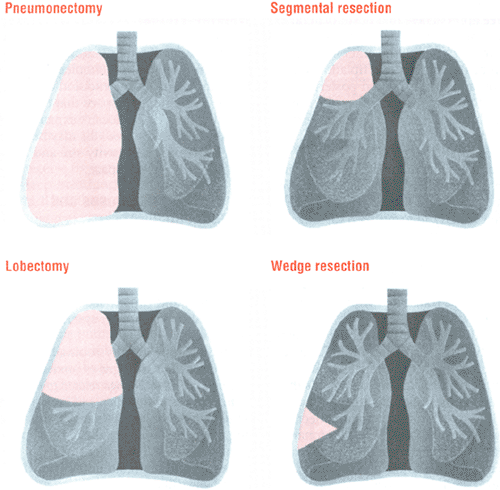Thoracotomy
A surgical incision into the thoracic cavity, a thoracotomy is done to locate and examine abnormalities, such as tumors, bleeding sites, or thoracic injuries; to perform a biopsy; or to remove diseased lung tissue. This procedure is most commonly performed to remove part or all of a lung to spare healthy lung tissue from disease. Lung excision may involve pneumonectomy, lobectomy, segmental resection, or wedge resection.
A pneumonectomy is the excision of an entire lung. It’s usually performed to treat bronchogenic cancer but may also be used to treat tuberculosis, bronchiectasis, or lung abscess. It’s used only when a less radical approach can’t remove all diseased tissue. After pneumonectomy, chest cavity pressures stabilize and, over time, fluid fills the cavity where lung tissue was removed, preventing significant mediastinal shift.
The removal of one of the five long lobes, lobectomy can treat bronchogenic cancer, tuberculosis, lung abscess, emphysematous blebs, benign tumors, or localized fungal infections. After this surgery, the remaining lobes expand to fill the entire pleural cavity.
Segmental resection is the removal of one or more lung segments and preserves more functional tissue than lobectomy. It’s commonly used to treat bronchiectasis. Remaining lung tissue needs to be reexpanded.
The removal of a small portion of the lung without regard to segments, wedge resection preserves the most functional tissue of all the surgeries but can treat only a small, well-circumscribed lesion. Remaining lung tissue needs to be reexpanded. (See Understanding types of lung excision.)
Other types of thoracotomy include the following.
Exploratory thoracotomy is done to examine the chest and pleural space in evaluating chest trauma and tumors.
Decortication is used to help reexpand the lung in a patient with empyema. It involves the removal or stripping of the thick, fibrous membrane covering the visceral pleura.
Thoracoplasty is performed to remove part or all of one rib and to reduce the size of the chest cavity. It decreases the risk of mediastinal shift when tuberculosis has reduced lung volume.




